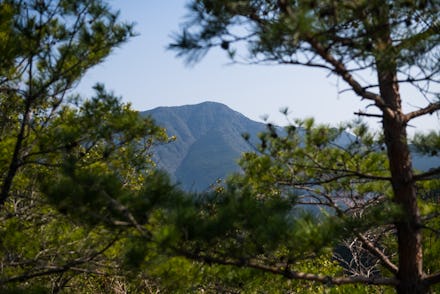Hiking the sacred Kumano Kodo route in Japan with a backpack and a “no Trump talk” pact

My concentration is completely focused on footfalls, specifically where my feet are landing among the cedar roots that form a natural staircase. I’m ascending Mount Tsurugi, on the Kii Peninsula, from the Takijiri-oji Shrine, on an 11-day trip thats covers the famous Kumano Kodo trail.
When I first set out on this pilgrimage, my goal was to escape the inescapable — a never-ending stream of U.S. political updates and urban clatter. The first Japanese emperor to hike the trail did so in the 11th century, after his retirement — possibly to seek absolution for his courtly life and imperial decisions.
I was invited by REI Adventures to hike the Kumano Kodo and Nakasendo trails with five other hikers, to experience this new trip. It’s part of their level-two offerings, which are designed for leisurely hikers — those who prefer no pre-trip calisthenics and like to conclude a few mellow hours on the trail with a soft bed and warm, multicourse meal. We spend each evening in a ryokan, a traditional inn where we soak in onsen, the geothermal communal baths. Level-two trips also feature more cultural components, in this case two days each in Kyoto and Tokyo. The six of us all shared a desire to escape the political din — we swiftly established a “no Trump talk” pact on day one — and to bathe in this largely “no service” wilderness.
“The six of us all shared a desire to escape the political din — we swiftly established a ‘no Trump talk”’pact on day one.”
A thousand years after it was first established, the Kumano Kodo Pilgrimage remains immensely popular, with up to 15 million annual visitors. Traversing the Kii Hanto, Japan’s largest peninsula, the routes are recognized as a Unesco World Heritage site, sibling to Spain’s Camino de Santiago pilgrimage route. The first emperor’s procession required 30 days to reach the Nakahechi trailhead from Kyoto. We arrived from Kyoto in three hours via train and public bus.
The search for silence
My quest for tranquility began with ringing a bell at the Takijiri-oji Shinto Shrine, located at the entrance to the Nakahechi wilderness. At the shrine, I was introduced to Shintoism — a religion with no founder and no fundamental precepts other than that kami, i.e. gods, exist throughout nature. The Shinto perspective celebrates aesthetics, emotions and the ability to see the beauty and goodness in all things. In an era of public vitriol and divisiveness, Shintoism provides an antidote worth consideration.
In Shintoism, one can cleanse past transgressions by ringing a bell followed by a bow, clapping the hands twice, then performing a prayer and another bow. I’m not trying to convert anyone — our guide told us the word doesn’t even exist in the Japanese language — but launching an alpine forest hike at a shrine devoted to animistic deities feels right. I step beneath the torii (gate) along the side — only priests may pass through the gate in the middle — complete the Shinto ritual at the shrine and begin the steep climb into the woods.
The three-mile trail climbs over 1,200 feet from Takijiri-oji to Takahara, the village where we will conclude our three-hour hike. About 20 minutes into our walk we come upon Chichi-iwa Rock. Our guide tells us that the wife of the Hidehira Fujiwara, a powerful clan leader, gave birth to her child here during their pilgrimage. They left the child in the small cave and the infant was saved by a wolf who nourished the baby by dripping her milk down the rock. The child’s parents returned after their pilgrimage, collected their healthy infant son and returned home. Most trailside shrines are maintained by local villagers who tend them meticulously, adding fresh flowers and foliage, candles and offerings of tea.
Near the end of the hike is the Takahara Shrine, located among rare 1,000-year-old camphor trees on the outskirts of the eponymous village. This Buddhist shrine was constructed between 1392 and 1573 during the early Muromachi period. The shrine presumably houses a copper image of the Buddha, dating back to 1403, hidden from view, as is typical of sacred Buddhist objects.
During the hike, I was surprised how young the trees appeared to be before I learned the kusonoki (camphor tree) that once populated this region were systematically removed during the Meiji period, which lasted from 1868 to 1912. Emperor Meiji, determined to transport his country rapidly away from the feudal samurai-led society into modernity, razed many historical castles and some shrines as well.
The ancient camphor trees, with their massive girth and labyrinthine branches, fell under the same wave of modernization. According to our guide, these rare ancient trees at the Takahara Shrine still exist because the local Takahara leaders feted the axe-wielding Meiji officials so thoroughly that they departed the next morning yielding nothing more from their excavation mission than heavy sake-induced hangovers.
Japan’s relationship with nature has always fascinated me, though my impressions had previously only come from literature, gardening books and Japanese gardens in the Pacific Northwest. I thought Japanese gardens were all about the dry garden, the bonsai, the koi pond. But the actual wilderness is just that — wilder.
For seven days I was surrounded by an unkempt tangle of exposed roots, erratic boulders and, in apparently every mountain village, infinite natural springs. At no point was anyone glued to their phone, checking news sites or scorning at hostile tweets. Settling into the comforting onsen after another day on the trail, I resolved to be more purposeful in my own relationship with silence — and to supplant my cacophonous routine back in Seattle with intentional installments of quiet.